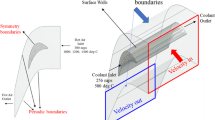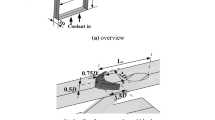Abstract
The objective of this paper is to designed a nonuniform arrangement of elliptical holes for film cooling (FICO) on gas turbine blades. The optimal distance between rows of holes (1–3) was determined to maximize FICO effectiveness. The three-dimensional geometry of the problem (Circle, horizontal elliptic, and vertical elliptic) was modeled based on an existing experimental sample. The turbulent steady-state incompressible single-phase flow was modeled using conservation equations and considering the blowing ratio (0.25–2), adiabatic FICO efficiency, von Mises stress (VMS), and hydraulic radius relationships. Results showed that elliptical holes with a major diameter normal to the flow had the highest centerline and laterally averaged effectiveness values. Additionally, holes that were more laterally stretched out had higher efficiency. The best effectiveness was achieved at an optimal blowing ratio of 0.75. Furthermore, the maximum von Mises stress was higher in cases with smaller distances between rows. Von Mises stress analysis revealed that elliptical openings with a large diameter perpendicular to the flow caused the lowest thermal stress in the solid body. When cooling with three rows of elliptical holes, a larger distance between the second and third rows resulted in higher effectiveness and lower maximum VMS at an optimal distance.






















Similar content being viewed by others
Abbreviations
- FICO:
-
Film cooling
- VMS:
-
Von Mises stress
- FLP:
-
Flat plate
- CLH:
-
Cooling hole
- M:
-
Blowing ratios
- CLEF:
-
Cooling effectiveness
References
Han J-C. Fundamental gas turbine heat transfer. J Therm Sci Eng Appl. 2013;5:021007.
Nourin FN, Amano RS. Experimental study on flow behavior and heat transfer enhancement with distinct dimpled gas turbine blade internal cooling channel. J Energy Resour Technol. 2022;144:112105.
Unnikrishnan U, Yang V. A review of cooling technologies for high temperature rotating components in gas turbine. Propuls Power Res. 2022;11:293.
Friedrichs S. Endwall film-cooling in axial flow turbines. New Jersey: Citeseer; 1997.
Han J-C, Rallabandi A. Turbine blade film cooling using PSP technique. Front Heat Mass Transf (FHMT). 2010;1:21.
Bayareh M. An overview of non-Newtonian nanofluid flow in macro- and micro-channels using two-phase schemes. Eng Anal Bound Elem. 2023;148:165–75.
Zhao W, Chi Z, Zang S. Scaling criteria accuracy for turbine blade film cooling effectiveness at unmatched temperature ratio conditions. Appl Therm Eng. 2021;197:117363.
Goldstein RJ. Film cooling. In: Advances in heat transfer, vol. 49. Amsterdam: Elsevier; 2017. p. 91–156.
Ligrani P, Wigle J, Ciriello S, Jackson S. Film-cooling from holes with compound angle orientations: part 1—results downstream of two staggered rows of holes with 3d spanwise spacing. J Heat Transf. 1994;116:352.
Bunker RS. Film cooling effectiveness due to discrete holes within a transverse surface slot. Turbo Expo Power Land Sea Air. 2002;36088:129–38.
Kanani H, Shams M, Ebrahimi R, Ahmadian T. Numerical simulation of film cooling effectiveness on a flat plate. Int J Numer Meth Fluids. 2008;56:1329–36.
Koç I. Experimental and numerical investigation of film cooling effectiveness for rectangular injection holes. Aircr Eng Aerosp Technol. 2007;79:621.
Jones FB, Fox DW, Oliver T, Bogard DG. Parametric optimization of film cooling hole geometry. In: Turbo expo: power for land, sea and air. Beijing: American Society of Mechanical Engineers; 2021.
Cao N, Li X, Wu Z, Luo X. Effect of film hole geometry and blowing ratio on film cooling performance. Appl Therm Eng. 2020;165:114578.
Song YJ, Park SH, Kang YJ, Kwak JS. Effects of trench configuration on the film cooling effectiveness of a fan-shaped hole. Int J Heat Mass Transf. 2021;178:121655.
Hang J, Zhang J, Wang C, Shan Y. Numerical investigation of single-row double-jet film cooling of a turbine guide vane under high-temperature and high-pressure conditions. Energies. 2022;15:287.
Zhang B, Chen Y-X, Wang Z-G, Li J-Q, Ji H-H. Influence of Mach number of main flow on film cooling characteristics under supersonic condition. Symmetry. 2021;13:127.
Zhou J, Wang X, Li J, Lu H. Effects of diameter ratio and inclination angle on flow and heat transfer characteristics of sister holes film cooling. Int Commun Heat Mass Transfer. 2020;110:104426.
Zhu R, Lin E, Simon T, Xie G. An experimental study of sister holes film cooling with various secondary-to-primary hole diameter ratios. J Heat Transf. 2021;143:012301.
Li H-W, Zhang D-W, Han F, Guo H, Ding X-F. Experimental investigation on the effect of hole diameter on the leading edge region film cooling of a twist turbine blade under rotation conditions. Appl Therm Eng. 2021;184:116386.
Gao F, Duan X, Zhang L, Chang J. Influence of groove structure on film cooling. Energy Rep. 2022;8:136–51.
Yu Z, Li C, An B, Liu J, Xu G. Experimental investigation of film cooling effectiveness on a gas turbine blade pressure surface with diffusion slot holes. Appl Therm Eng. 2020;168:114851.
Daud H, Mohammed M. Film cooling holes performance on a flat plate. J Mech Eng. 2022;19:73–91.
Zhu R, Lin E, Simon T, Xie G. Investigation and numerical simulation on film cooling performance with an anti-vortex hole design: influences of diameter ratio. Int Commun Heat Mass Transf. 2021;121:105118.
Yao J, Su P, He J, Wu J, Lei J, Fang Y. Experimental and numerical investigations on double-jet film-cooling with different mainstream incidence angles. Appl Therm Eng. 2020;166:114737.
Zhou Z, Li H, Xie G, Xia S, Zhou J. The cooling performance of three-row compound angle holes on the suction surface of a rotating turbine blade. Propuls Power Res. 2021;10:23–36.
Meng L, Li H, Xie G, Tao Z, Zhou Z. Film cooling performance of blade pressure side with three-row film holes under rotating condition. Int J Heat Mass Transf. 2022;188:122593.
Rui Z, Terrence S, Shulei L, Gongnan X. Film cooling performance and flow structure of single-hole and double-holes with swirling jet. Chin J Aeronaut. 2022;35:201–13.
Chang J, Xu J, Duan X, Wang K, Du Y. Investigations of effect for different influencing factors on film cooling effectiveness—steady coolant ejected. Energy Rep. 2021;7:1453–65.
Paregouda S, Rao T. CFD simulation on gas turbine blade and effect of hole shape on leading edge film cooling effectiveness. Int J Modern Eng Res. 2013;3:2066–72.
Sinha A, Bogard D, Crawford M. Film-cooling effectiveness downstream of a single row of holes with variable density ratio. J Turbomach. 1991;113:442.
White FM, Majdalani J. Viscous fluid flow. New York: McGraw-Hill; 2006.
Wilcox DC. Turbulence modeling for CFD. CA: DCW industries La Canada; 1998.
Dai S-J, Xiao Y, He L-M, Jin T, Zhang Q, Hou P-H, Zhao Z-C. Film-cooling of cylindrical hole with downstream surface dielectric barrier discharge actuators. Int J Heat Mass Transf. 2015;90:825–37.
Öztop HF. Turbulence forced convection heat transfer over double forward facing step flow. Int Commun Heat Mass Transf. 2006;33:508–17.
Kim KM, Moon H, Park JS, Cho HH. Optimal design of impinging jets in an impingement/effusion cooling system. Energy. 2014;66:839–48.
Wiwatanapataphee B, Sawangtong W, Khajohnsaksumeth N, Wu YH. Oscillating pressure-driven slip flow and heat transfer through an elliptical microchannel. Adv Differ Equ. 2019;1–9:2019.
Sepyani M, Shateri A, Bayareh M. Investigating the mixed convection heat transfer of a nanofluid in a square chamber with a rotating blade. J Therm Anal Calorim. 2019;135:609–23.
Author information
Authors and Affiliations
Corresponding author
Additional information
Publisher's Note
Springer Nature remains neutral with regard to jurisdictional claims in published maps and institutional affiliations.
Rights and permissions
Springer Nature or its licensor (e.g. a society or other partner) holds exclusive rights to this article under a publishing agreement with the author(s) or other rightsholder(s); author self-archiving of the accepted manuscript version of this article is solely governed by the terms of such publishing agreement and applicable law.
About this article
Cite this article
Daneh-Dezfuli, A., Kazemzadeh, R. & Hajatzadeh Pordanjani, A. Numerical simulation and design of non-uniform arrangement of circular and elliptical holes on the effectiveness of film cooling of a gas turbine blades. J Therm Anal Calorim 149, 4671–4690 (2024). https://doi.org/10.1007/s10973-024-13239-9
Received:
Accepted:
Published:
Issue Date:
DOI: https://doi.org/10.1007/s10973-024-13239-9




